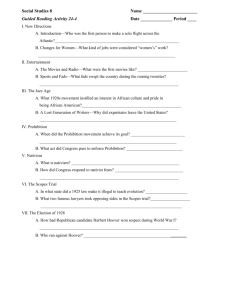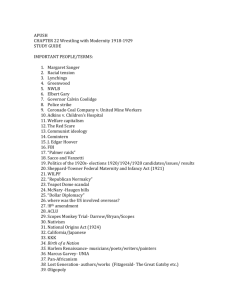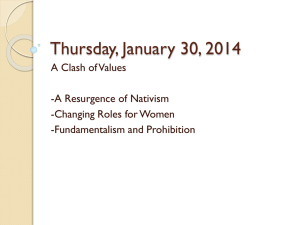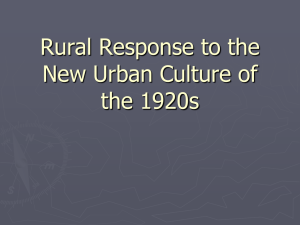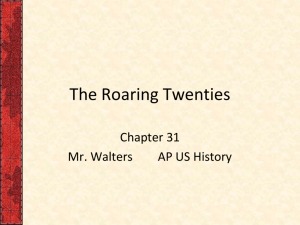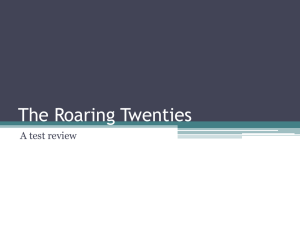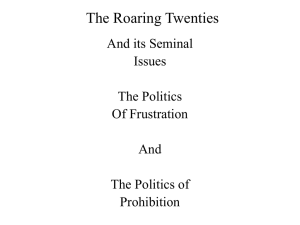Ch. 25 Outline - Silva Classes
advertisement
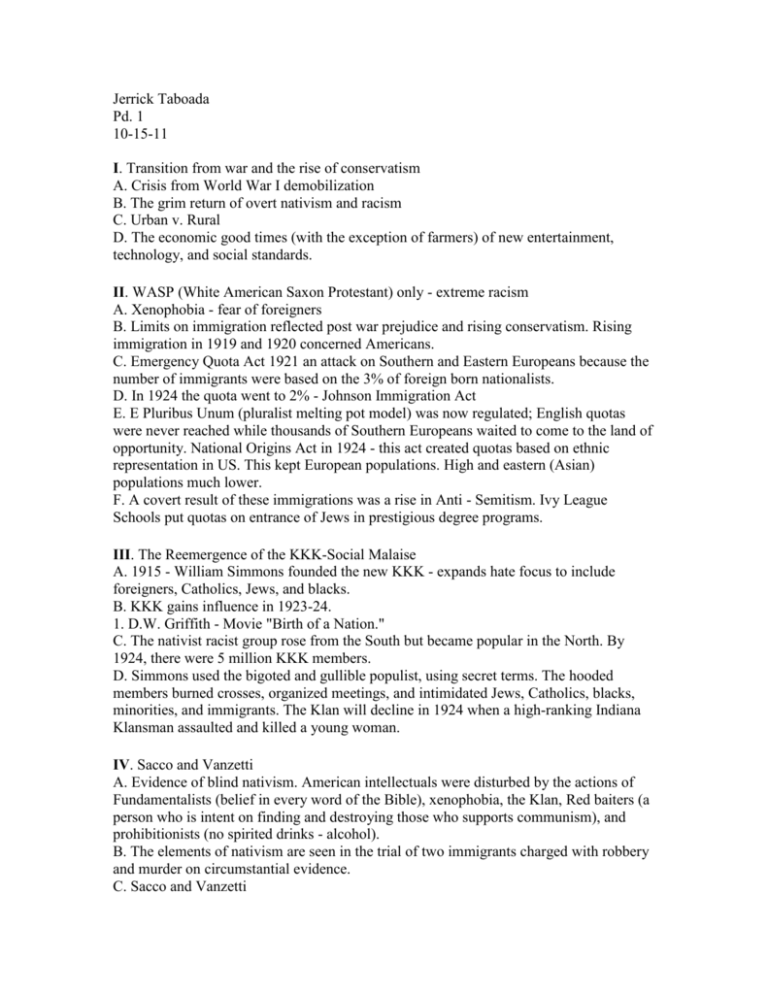
Jerrick Taboada Pd. 1 10-15-11 I. Transition from war and the rise of conservatism A. Crisis from World War I demobilization B. The grim return of overt nativism and racism C. Urban v. Rural D. The economic good times (with the exception of farmers) of new entertainment, technology, and social standards. II. WASP (White American Saxon Protestant) only - extreme racism A. Xenophobia - fear of foreigners B. Limits on immigration reflected post war prejudice and rising conservatism. Rising immigration in 1919 and 1920 concerned Americans. C. Emergency Quota Act 1921 an attack on Southern and Eastern Europeans because the number of immigrants were based on the 3% of foreign born nationalists. D. In 1924 the quota went to 2% - Johnson Immigration Act E. E Pluribus Unum (pluralist melting pot model) was now regulated; English quotas were never reached while thousands of Southern Europeans waited to come to the land of opportunity. National Origins Act in 1924 - this act created quotas based on ethnic representation in US. This kept European populations. High and eastern (Asian) populations much lower. F. A covert result of these immigrations was a rise in Anti - Semitism. Ivy League Schools put quotas on entrance of Jews in prestigious degree programs. III. The Reemergence of the KKK-Social Malaise A. 1915 - William Simmons founded the new KKK - expands hate focus to include foreigners, Catholics, Jews, and blacks. B. KKK gains influence in 1923-24. 1. D.W. Griffith - Movie "Birth of a Nation." C. The nativist racist group rose from the South but became popular in the North. By 1924, there were 5 million KKK members. D. Simmons used the bigoted and gullible populist, using secret terms. The hooded members burned crosses, organized meetings, and intimidated Jews, Catholics, blacks, minorities, and immigrants. The Klan will decline in 1924 when a high-ranking Indiana Klansman assaulted and killed a young woman. IV. Sacco and Vanzetti A. Evidence of blind nativism. American intellectuals were disturbed by the actions of Fundamentalists (belief in every word of the Bible), xenophobia, the Klan, Red baiters (a person who is intent on finding and destroying those who supports communism), and prohibitionists (no spirited drinks - alcohol). B. The elements of nativism are seen in the trial of two immigrants charged with robbery and murder on circumstantial evidence. C. Sacco and Vanzetti 1. Charged with robbery and murder 2. Evidence against them was weak 3. Executed even after appeals by the ACLU 4. Terribly biased judge 5. Being radicals and aliens led to their execution, not actually committing a crime. V. The New Negro and the Harlem Renaissance A. Increased migration of African Americans to northern urban areas - mass demographic change. Rising tension brought on by the KKK, lynching, and ghetto existence in northern cities, both positive and negative movements emerged. B. Du Bois spoke of the abuses of segregation, and racism in "The Crisis" in 1919, and toyed with Black Nationalism, but he never made up his mind if he was a Black Integrationist or Black Separatist. C. Marcus Garvey, a Jamaica born leader of the Black Nationalist (separatist) Movement, sponsored a back-to-Africa movement that was supported by some (including KKK whites) but proved to be a false profit because the rise of an African American selfimage. Garvey had nothing but contempt for whites and the NAACP. D. Garvey ran the Universal Negro Improvement Association that attempted to create economic opportunities. E. The Harlem Renaissance was a cultural period of new and innovative art. It was an unprecedented break of the barrier of racism and blacks upheld themselves as standards of excellence in visual arts. 1. Jazz, Art, Literature, Music, and Dance broke the color line. a. Louis Armstrong b. Langston Hughes - "The Weary Blues" c. Bessie Smith - female blues singer d. Claude McKay - poet - urged blacks to resist discrimination e. Countee Cullen - "Color" - captured black struggle f. Satchel Paige - athlete who still played in segregated league. VI. Modernism V. Fundamentalism or Urban V. Rural A. John T. Scopes a biology teacher in Tennessee - Where a law was passed in 1925 to forbid the teaching of Darwin's Theory. B. Scopes Monkey Trial - Darwin's "Origins of the Species." A Radio Trial. Technology is key - creates media event. 1. Clarence Darrow v. William Jennings Bryan (Cross of Gold Speech) 2. Liberal v. Conservative - evidences a classic argument of modernism (science) and fundamentalism (faith) 3. Urban v. Rural 4. ACLU defends John T. Scopes in an important case C. Darrow was Chief Counsel to Scopes and used the trial to expose the failure of Fundamentalist logic. Modernism did lose. D. Bryan put himself on the stand as an expert witness and exposed his childlike faith of the literal interpretation of the bible - Eve came from Adam's rib, Jonah was swallowed by a whale, etc. E. The trial ended and fundamental movements continued. Evolution was not allowed to be taught in Tennessee until the 1970's. VII. Prohibition A. Grassroots movement originating in rural areas and Bible Belt B. The 18th amendment -1919 (created and enforced prohibition) passed as did the Volstead Act - 1919 which enforced the law. A clear victory for the grassroots fundamentalist reform movement (a reform movement that starts at the local/city level). WWI aided the cause to save grain and opposed Germans who drank beer. C. Prohibition was a dismal failure of social engineering. A battle between the Wets (against prohibition; like alcohol) and the Drys (for prohibition; against alcohol). D. The Drys won for a short term and some improvements were noted both socially and medically. E. Drys continued the work of Carrie Nation, notorious member of the Anti-Saloon League. F. Spirited drink was still in high demand and a lucrative black market rose to sell the new contraband. G. New forms of Black Market business arose, evidence: illegal stills and bootleggers who ran liquor across borders. H. Saloons and bars became speakeasies (a bar or distillery that was hidden in another business. Passwords used to enter bars.) Other sources for alcohol included druggists and churches (first years of prohibition evidenced an 800,000 gallon increase of sacramental wine.) I. Al Capone - illegal liquor trade in Chicago and the Midwest. J. Prohibition was clearly a failure and needed to be overhauled or terminated, politicians recognized this but the fundamentalist would not budge on the issue. VII. Literature - The Lost Generation - Many left for Europe A. Many ultra-liberal writers became disillusioned with the "American Renaissance" so they left the US. Evidence: Upton Sinclair - became very cynical and referred to the USA as the "botched civilization." B. These liberal authors wrote many works that criticized WWI, red baiters, the KKK, and fundamentalists. This concern and cynicism was reflected in the "Lost Generation" or the Bohemian Movement of writing. C. Greenwich Village Bohemians criticized the war and also the loss of Progressive zeal within the US. D. Sinclair Lewis wrote "Dodsworth," "Main Street," and "Babbitt" - describes business greed. E. Thorstine Veblin wrote "Business Enterprise" - this was a dose of Marxism but urged the public planning for general welfare. F. T.S. Elliot wrote "The Wasteland," a poem of a disillusioned culture G. Henry L. Mencken, ("The American Mercury") - a betrayal of progressives and he also reported on the Scopes Monkey Trial. He coined the phrase booboisie (the wealthy class) and "honest imbecility" to describe President Harding. H. Ernest Hemingway wrote "Sun Also Rises" and "A Farewell to Arms" which were anti-war. His writing was popular in his time I. F. Scott Fitzgerald wrote "The Great Gatsby"(1925) which was about a millionaire and greed - an attack on the society of wealth. His book, "This Side of Paradise", (1920) regarded the crisis and confusion of his generation. IX. New Urban Ideas A. Massive demographic shift from rural to urban. For the first time in our nation's history, more people resided in cities rather than in rural areas. 1. This marked a dramatic shift in the nation's self-image. 2. People left the farm to go to the city. This created changes in worldview, employment, education, and technology. 3. Compulsory (required) education and child labor laws improved lives of youth. 4. Women, particularly married women worked outside the home more often. Rising image of the New Woman - a break from traditional social role. 5. The idea of interfamily democracy arose. This created shared duties within the household; as a result, divorce rose. This all caused a redefinition of marriage in general. More liberal views on child rearing, sexuality, and education conflicted dramatically with the Victorian moral code. B. Rise of Big Business 1. Prosperity followed in the economy and in business. 2. The USA held 40% of the world's wealth. And the goal of the conservative government was to protect the position of the wealthy - Andrew Mellon. 3. Greater demand for consumer goods evolved. This created new means of production, and a rise in electrical use. Phone systems emerged in greater numbers and new equipment including pneumatic tools were created. This all caused industrial output to soar. 4. The efficiency of electricity and new forms of business practice increased production and decreased cost. 5. Shift of Women's democracy in families - spending money C. Frederick Taylor- was the father of scientific management. Did time and motion studies - Taylorism (model of efficiency) or "Shop management" D. Henry Ford 1. Assembly line - to better mass production 2. High wages, efficiency, and mass production led to a large economy of scale and to profit, which increased the velocity of life. 3. Specialization - becoming proficient in a specific area 4. Model T - was called the "Tin-lizzy." E. Ford who was a talented and respected manufacturer did have problems in dealing with unions, spying, and was anti-Semitic. When he ran for president these defects hurt him. Furthermore, the Model T was not changed for 20 years and became obsolete, which allowed competitors like GM to step in. F. The primary industry that drove the economy in the 20's and transformed our society was the automobile industry - KEY. G. Henry Ford - cars for everyone (affordable) - industrial boom. Spurred other industries like: 1. Steel 2. Oil 3. Highways 4. Greater mobility and spurred new spinoff industries like vacation areas, gas stations, garage builders, sidewalks. 5. The availability of automobiles spurred more recreation and the movement of rural America to urban America. This began the concept of commuter populations and empowered urban flight. 6. Also huge problems are created by cars - congestion and pollution. X. Coolidge conservatism - "a man who builds a factory...builds a temple". Materialist and elitist A. Andrew Mellon - laissez faire - He wanted to decrease government interference and he supported Trickle Down Economics and/or Supply Side Economics - massive tax cuts to wealthy. B. Bureau of Budget 1921 -reduce debt - reflects conservative tone of the time. C. Norris LaGuardia Anti-Injunction Act 1932 - outlawed yellow dog contracts that were intended to restrict strikes (contract workers were "pressured" into signing). D. Bruce Barton - "The Man Nobody Knows" He was a radical who believed that Jesus was an adman - fundamentalist and business conservative blended. E. Ads and Mass marketing - consumerism F. Later Speculation 1. Land 2. Stocks XI. The age of the consumer, entertainment, and new social standards A. Sports, big money, and superstars 1. Baseball - Ty Cobb and Babe Ruth "Sultan of Swat" 2. Boxing - Jack Dempsey 3. Track, football, baseball - Jim Thorpe (Native American) 4. Football - Red Grange 5. Swimmer - Gertrude Ederle was a great swimmer and swam the English Channel faster than any man before! 6. Recreational sports grew dramatically. 7. Social changes represent new consumer period B. Electricity - save time and effort 1. Appliances 2. City lights 3. Street cars C. Radio ads, education, and entertainment 1. Ads of questionable value and validity 2. Regulated by FCC (Federal Communication Commission) D. Music 1. Phonographs 2. Jazz and opera 3. Lewis Armstrong E. Movies 1. The Great Train Robbery 2. Talkies "Jazz Singer" - 1927 3. New stars and heroes - Clara Bow, Charlie Chaplin, Rudolph Valentino 4. Greater use of sex, crime, war, romance, and comedy within movies F. Changing styles and morals 1. Key shift from Victorian to "modern" ideologies 2. This created a dramatic generation gap a) Jazz b) Drinking and smoking c) Dating was no longer supervised by parents d) Use of make-up and "exotic perfume" e) New controversial fashions 3. Freudians (followers of Sigmund Freud) claimed it was irrepressible sex drive, thus casting inhibitions aside. 4. Conservative Victorians felt this radical behavior cast aside moral standards. Extra curricular behaviors dominated - sororities, fraternities, prom, and football games. G. The "New" Women 1. May have been more open-minded and departed from Victorianism, but most did not practice premarital sex. 2. Radical feminist - Margaret Sanger was in favor of birth control. She did not promote the cause of birth control for the purpose of promiscuity, but for the purpose of aid poor women who were overburdened with children and seemed to be caught in a cycle of pregnancy and poverty. The circulation of this information was against the law until the 1960's. 3. Divorce was easier for women and with more women working in service positions, this became a realistic option - to leave a marriage and support themselves. 4. Women faced a double standard in the work place, facing lower wages and less promotion opportunities compared to men of equal training and skill. 5. Unfortunately the social feminist movement led by Carrie Chapman Catt slowly declined. H. Hype media - advertising 1. Image is everything 2. Sports heroes pitch products I. Sensationalism and Heroes 1. Lindbergh - worship is key - stresses individualism and American pride, hero. 2. Fads XII. The Air Plane A. Lockheed produced airplanes for commercial flights. B. Great improvements since WWI C. Charles Lindbergh (known as "Lucky Lindy") flew his plane, the "Spirit of St. Louis", across the Atlantic Ocean non-stop. This success increased the American public's interest in flight. D. Lindbergh flew the "Spirit of St. Louis" which led to the creation of new innovations in planes, contrasting with the period. E. Bill Mitchell's (an aviation zealot who predicted the attack on Pearl Harbor) warnings regarding military use of planes loom but are ignored.
